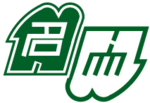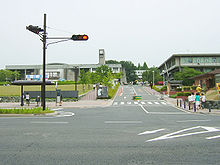- Nagoya University
-
Nagoya University 名古屋大学 
Motto None Established Founded 1871,
Chartered 1939Type Public (National) President Michinari Hamaguchi Academic staff 1,793 Undergraduates 9,818 Postgraduates 5,993 Location Nagoya, Aichi, Japan Campus Urban,
3.2 km²Colors Green Mascot None Website www.nagoya-u.ac.jp Nagoya University (名古屋大学 Nagoya daigaku), abbreviated to Meidai (名大),[1] is a Japanese national university headquartered in Chikusa-ku, Nagoya. It is one of the former 9 imperial universities.
Contents
History
Nagoya University traces its roots back to 1871 when it was a temporary medical school. In 1939 it became Nagoya Imperial University. In 1947 it was renamed Nagoya University. In 2004 it became a National University Corporation.
The ideal written in the Nagoya University Academic Charter is to encourage the intelligentsia with courage by providing an education which respects independent thought.
While the majority of its students come from Tōkai region, Nagoya University has a good portion of students from all over Japan.
It also receives many students from abroad. Currently there are over 1300 foreign students (150 undergraduate) from 78 countries studying in the various faculties of Nagoya University. The majority of them are from China (47%, as of May 1, 2009) and Korea (9.5%). Among other countries, Taiwan, Indonesia, Viet Nam, Malaysia, Cambodia and Uzbekistan are represented by more than 30 students. The United States and Brazil with 16 students each are the most represented non-Asian countries.
Notable alumni and affiliates include four Nobel Prize winners. Dr. Ryōji Noyori, one of the 2001 Nobel Prize in Chemistry winners spent most of his academic career researching and teaching at the university.
Reiji Okazaki (岡崎令治) , discoverer of the Okazaki fragments, graduated from Nagoya and was a professor at the university.
Yoshinori Kidani, discoverer of the cancer drug oxaliplatin.
Faculties and Graduate Schools
Faculties
- Law
- Medicine
- Engineering
- Letters
- Science
- Agriculture
- Economics
- Education
- Information Culture
Graduate Schools
- Educational Glowing
- Law
- Economics
- Arts and Sciences
- Science
- Mathematics
- Engineering
- Life Sciences and Agriculture
- Medicine
- International Language Culture
- International Development (GSID)
- Environment
- Information Science
The University's Research Center for Seismology, Volcanology and Disaster Mitigation is represented on the national Coordinating Committee for Earthquake Prediction.[2]
Academic Rankings
University rankings (overall) Toyo Keizai National[3] General 21 Kawaijuku National[4] General 8 T. Reuters National[5] Research 5 WE National[6] Employment 38 NBP Hokuriku/Tokai[7] Reputation 1 Shimano National[8] Selectivity SA QS Asia[9] General 14 ARWU Asia/Pacific[10] Research 7 QS World[11] General 80 ARWU World[12] Research 79 University rankings (by subject) Social Sciences & Humanities LAW
Asahi National[13] Research 4 BE Success National[14] Qualification 12 BE Pass rate National[15] Qualification 10 ECONOMICS
RePec National[16] Research 13 Natural Sciences & Technology Engineering
Nikkei National[17] Research 9 PHYSICS
T.Reuters National[18] Research 6 T.Reuters World[18] Research 61 CHEMISTRY
T.Reuters National[18] Research 7 T.Reuters World[18] Research 43 BIOLOGY & BIOCHEMISTRY
T.Reuters National[18] Research 5 T.Reuters World[18] Research 97 * T. Reuters World rankings include non-educational institutions Nagoya University is one of the most prestigious universities in Japan. It can be seen in the several rankings such as shown below.
General Rankings
The university has been ranked 15th in 2009 and 21st in 2010 in the ranking "Truly Strong Universities" by Toyo Keizai.[3] In another ranking, Japanese prep school Kawaijuku ranked Nagoya as the 8th best university in Japan.[4]
The Academic Ranking of World Universities (ARWU) 2009 ranks Nagoya University as fourth in Japan.[19] The 2009 THE-QS World University Rankings (From 2010 two separate rankings will be produced by the Times Higher Education World University Rankings and the QS World University Rankings) ranks Nagoya University as fifth in Japan.[20] The 2010 QS Asian University Rankings rated Nagoya number ten in Asia and number five in Japan,[21] while the QS World University Rankings[22] for 2011 ranked Nagoya 80th in the world.
Research Performance
Nagoya is one of the top research institutions in Japan. According to Thomson Reuters, Nagoya is the 5th best research university in Japan.[5] Its research standard is especially high in Physics (6th in Japan, 61st in the world), Chemistry (7th in Japan, 43rd in the world), Biology & Biochemistry (5th in Japan, 97th in the world).[23]
Weekly Diamond also reported that Nagoya has the 6th highest research standard in Japan in terms of research funding per researchers in COE Program.[24] In the same article, it's also ranked 6th in terms of the quality of education by GP funds per student.
In addition, Nikkei Shimbun on 2004/2/16 surveyed about the research standards in Engineering studies based on Thomson Reuters, Grants in Aid for Scientific Research and questionnaires to heads of 93 leading Japanese Research Centers, and Nagoya was placed 9th (research planning ability 5th//informative ability of research outcome 9th/ability of business-academia collaboration 6th) in this ranking.[25]
Furthermore, Nagoya got the 8th position at the number of patents accepted (108) during 2009 among Japanese Universities.[26]
It also has a high research standard in Social Science & Humanities. Asahi Shimbun summarized the amount of academic papers in Japanese major legal journals by university, and Nagoya was ranked 4th during 2005-2009.[13] Repec in Jan 2011 ranked Nagoya's Economic department as Japan's 13th best economic research university.[27]Graduate school Rankings
Nagoya Law School is considered as one of top Law schools in Japan, as it was ranked 10th in the passing rate of Japanese Bar Examination in 2010.[28]
Alumni Rankings
According to the Weekly Economist's 2010 rankings, graduates from Nagoya have the 38th best employment rate in 400 major companies in Japan.[29]
Popularity and Selectivity
Nagoya is one of the most selective universities in Japan. Its entrance difficulty is usually considered as one of the top in Japan.[30][31]
Nikkei BP has been publishing a ranking system called "Brand rankings of Japanese universities" every year, composed by the various indications related to the power of brand, and Nagoya was top in 2010 in Hokuriku/Tokai Area.[32][7]
Notable alumni and faculty members
- Reiji Okazaki and Tsuneko Okazaki - Pioneering molecular biologists
- Ryōji Noyori - Nobel Prize in Chemistry 2001
- Makoto Kobayashi - Nobel Prize in Physics 2008
- Toshihide Maskawa - Nobel Prize in Physics 2008
- Osamu Shimomura - Nobel Prize in Chemistry 2008
- Nobuo Kato (加藤 延夫) - Bacteriologist, former President of Nagoya University (1992–1998)
- Minoru Matsuo (松尾 稔) - Engineering scientist, former President of Nagoya University (1998–2004)
- Shinichi Hirano (平野 眞一) - Engineering scientist, director of National Institution for Academic Degrees and University Evaluation, former President of Nagoya University (2004–2009)
- Tang Jun, President and CEO of Xin Hua Du Industrial Group Co.
- Uichiro Niwa (丹羽 宇一郎) - Japanese Ambassador to China, former Chairman and President of Itochu, former CEO of Japan Post Holdings
- Hiromu Okabe(岡部 弘) - former President and CEO of Denso
- Kunihiko Okada (岡田 邦彦) - former Chairman of J. Front Retailing
- Sadayuki Sakakibara (榊原 定征) - President and CEO of Toray Industries, Chairman of Japan Chemical Fibers Association
- Masaharu Shibata (柴田 昌治) - Chairman and CEO of NGK Insulators Ltd.
- Reiji Suzuki (鈴木 礼治) - politician, former governor of Aichi Prefecture (1983–1999)
- Shoichiro Toyoda - Ex-CEO of Toyota Motor
Full list can be found in the Japanese Wikipedia article: List of Nagoya University people (in Japanese)
References
- ^ Tokyo's Meiji University's 明大 is pronounced identically
- ^ Organizations with ties to CCEP CCEP, accessed 2011-03-19
- ^ a b "Truly Strong Universities" (in Japanese). Toyo Keizai. 2010. http://www.toyokeizai.net/business/industrial/detail/AC/7ca97f085eda34ce139f6d1210cef898/page/1/. Retrieved Apr 29, 2011.
- ^ a b "Kawai 30 Top Japanese Universities". Kawaijuku. 2001. http://www.nigelward.com/top30.html. Retrieved Apr 29, 2011.
- ^ a b "Thomson Reuters 20 Top research institutions in Japan". Thomson Reuters. 2011. http://science.thomsonreuters.com/press/2010/top-20-japanese-research-insts/. Retrieved Apr 29, 2011. (this raking includes 5 non-educational institutions)
- ^ "Employment rate in 400 major companies rankings" (in Japanese). Weekly Economist. 2011. http://www2.ttcn.ne.jp/honkawa/3865.html. Retrieved Apr 29, 2011.
- ^ a b "Nikkei BP Brand rankings of Japanese universities" (in Japanese). Nikkei Business Publications. 2010. http://trendy.nikkeibp.co.jp/article/pickup/20101108/1033562/. Retrieved Apr 29, 2011.
- ^ "GBUDU University Rankings" (in Japanese). YELL books. 2009. http://www.amazon.co.jp/%E5%8D%B1%E3%81%AA%E3%81%84%E5%A4%A7%E5%AD%A6%E3%83%BB%E6%B6%88%E3%81%88%E3%82%8B%E5%A4%A7%E5%AD%A6-%EF%BC%92%EF%BC%90%EF%BC%91%EF%BC%92%E5%B9%B4%E7%89%88-YELL-books-%E5%B3%B6%E9%87%8E-%E6%B8%85%E5%BF%97/dp/4753930181. Retrieved Apr 29, 2011.
- ^ "QS Asian University Rankings". QS Quacquarelli Symonds Limited. 2010. http://www.topuniversities.com/university-rankings/asian-university-rankings/2010. Retrieved Apr 29, 2011.
- ^ "Academic Ranking of World Universities in Japan". Institute of Higher Education, Shanghai Jiao Tong University. 2010. http://www.arwu.org/Country2010Main.jsp?param=Japan. Retrieved Apr 29, 2011.
- ^ "QS World University Rankings". QS Quacquarelli Symonds Limited. 2010. http://www.topuniversities.com/university-rankings/world-university-rankings/2010/results. Retrieved Apr 29, 2011.
- ^ "Academic Ranking of World Universities". Institute of Higher Education, Shanghai Jiao Tong University. 2010. http://www.arwu.org/Country2010Main.jsp?param=Japan. Retrieved Apr 29, 2011.
- ^ a b Asahi Shimbun University rankings 2010 "Publification rankings in Law (Page 4)" (in Japanese). Asahi Shimbun. 2010. http://www.law.kobe-u.ac.jp/faculty/annai/2011faculty.pdf. Retrieved May 11, 2011.
- ^ "Bar Exam Successful Applicants rankings" (in Japanese). Shikaku Seek. 2010. http://laws.shikakuseek.com/data/2010data-1.html. Retrieved May 11, 2011.
- ^ "Bar Exam Pass rate rankings" (in Japanese). Shikaku Seek. 2010. http://laws.shikakuseek.com/data/2010data-2.html. Retrieved May 11, 2011.
- ^ "Top 25% Institutions and Economists in Japan, as of January 2011". REPEC. 2011. http://ideas.repec.org/top/old/1101/top.japan.html. Retrieved May 11, 2011.
- ^ "Nikkei research standard rankings in Engineering" (in Japanese). Nikkei Shimbun. 2010. http://homepage3.nifty.com/katu-kobayashi/doppo/kougaku_kennkyu.htm. Retrieved May 11, 2011.
- ^ a b c d e f "Thomson Reuters 10 Top research institutions by subject in Japan" (in Japanese). Thomson Reuters. 2010. http://science.thomsonreuters.jp/press/release/2011/esi2011/ranking/. Retrieved May 11, 2011.
- ^ http://www.arwu.org/Country2009Main.jsp?param=Japan
- ^ http://www.timeshighereducation.co.uk/Rankings2009-Top200.html
- ^ http://www.topuniversities.com/university-rankings/asian-university-rankings/overall
- ^ http://www.topuniversities.com/university-rankings/world-university-rankings/2011?page=1
- ^ "Thomson Reuters 20 Top research institutions in Japan" (in Japanese). Thomson Reuters. http://science.thomsonreuters.jp/press/release/2011/esi2011/ranking/. (this raking includes non-educational institutions)
- ^ "週刊ダイヤモンド" ダイヤモンド社 2010/2/27 http://web.sapmed.ac.jp/kikaku/infomation/0227daiyamondokiji.pdf
- ^ http://homepage3.nifty.com/katu-kobayashi/doppo/kougaku_kennkyu.htm
- ^ (Japanese)2009年国内大学別特許公開件数, Japanese patent office, accessed May 3rd 2011
- ^ http://ideas.repec.org/top/old/1101/top.japan.html
- ^ http://laws.shikakuseek.com/data/2010data-2.html
- ^ "Employment rate in 400 major companies rankings" (in Japanese). Weekly Economist. 2011. http://www2.ttcn.ne.jp/honkawa/3865.html. Retrieved Apr 29, 2011.
- ^ e.g. Yoyogi seminar published Hensachi (the indication showing the entrance difficulties by prep schools) rankings http://www.yozemi.ac.jp/rank/gakubu/index.html
- ^ Japanese journalist Kiyoshi Shimano ranks its entrance difficulty as SA (most selective/out of 11 scales) in Japan. "危ない大学・消える大学 2012年版" (in Japanese). YELL books. 2011. http://www.amazon.co.jp/dp/4753930181.
- ^ http://consult.nikkeibp.co.jp/consult/release/ub091210a.html
External links
- The Nagoya University English website
- Nagoya Repository - collection of scholarly papers and dissertations by the faculty and students of Nagoya University.
National Seven Universities (Japan) National Universities Kyoto University | Kyushu University | Nagoya University | Osaka University | Tohoku University | University of Tsukuba | University of TokyoPrivate Universities International Forum of Public Universities (IFPU) Barcelona · Bologna · Brussels · Bucharest · Buenos Aires · California · Charles University in Prague · Cheikh Anta Diop · Chile · Freiburg · Geneva · Haiti · Jawaharlal Nehru · Lomonosov Moscow State · Mohammed V · Montréal · Nagoya · Nankai · Ouagadougou · Paris III · Peking · UNAM
Categories:- Educational institutions established in 1939
- Japanese national universities
- National Seven Universities
- Universities and colleges in Nagoya
- 1939 establishments in Japan
Wikimedia Foundation. 2010.



